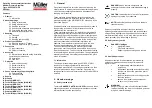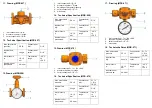
2.4 Unauthorized alterations and spare parts
Modification or alteration of the medium pressure regulator
types 057/058, 070/071 is not permitted. Original drawings
and accessories authorised by the manufacturer serve for
safety. The use of other parts or unauthorised modifications to
the medium pressure regulator types 057/058, 070/071 by
third parties invalidates the manufacturer's liability for the
consequences.
2.5 Permissible operating mode
•
liquid gas (gas phase), others on request
•
ex zone 1 or 2
•
under the container cover (above ground,
underground), in weather-protected outdoor areas,
•
in buildings and special installation rooms (according
to TRF 2012)
2.6 Inadmissible operating mode
•
ex-zone 0
•
operating modes that deviate from the permissible
operating modes and technical data
3. Handling
3.1 Transport
During all transportation, the generally recognised rules of
technology and the accident prevention regulations must be
strictly observed.
Handle the goods to be transported with care. During
transport, the pressure regulator must be protected against
shocks, blows or vibration.
Immediately after receipt of the goods, the delivery must be
checked for completeness and transport damage. See also
section 9.0.
3.2 Storage
If the pressure regulator is not installed immediately upon
delivery, it must be stored properly.
Storage temperature -20°C to +60°C, dry, free of dirt and
protected from moisture.
3.3 Handling prior assembly
•
Protect from weather influences such as wetness.
•
Make sure that the product is free from dust and
foreign particles.
4. Product specification
4.1 Pressure regulator 1
st
stage
The 1
st
stage pressure regulator reduces the unregulated
pressure from the liquid gas container to a set outlet pressure.
4.2 Pressure Relief Valve (PRV) optional
The PRV (Pressure Relief Valve) is closed during normal
operation and is designed to automatically release the gas
flow with limited flow when the pressure in the system to be
protected reaches the set pressure. This is relieved via the
regulator's venting port. It closes again automatically when
the pressure drops below the set pressure.
The outlet opening must be protected against rainwater.
It is important to note that pressure regulators which
are operated inside a building, an enclosure or a
hazardous area must be provided with a vent line to
the outside.
Please observe this information, otherwise liquid gas
can escape in the building, which may lead to an
explosion.
Insect screen with filter screen must be screwed into
the vent on the regulator. It must be checked
regularly whether the screen is free from dirt. A
clogged screen can lead to increased or too low
outlet pressures and thus to a response of the
OPSO.
5. Connectors
5.1 Input connectors
•
Threaded connection:
G.2 = 21 x 1,814, LH-60° tightening by hand
•
Threaded connection:
G.3 = M16 1,5 RH tightening by hand
Other connections on request!
5.2 Output connectors
•
Threaded connection:
H.2 = 21,7 x 1,814, LH-60° tightening by hand
•
Threaded connection:
H.3 = M16 1,5 RH tightening by hand
6. Assembly
6.1 Information on hazards during installation, operation
and maintenance
DANGER!
Safe operation of the pressure regulator is only
guaranteed if it is installed and commissioned by
qualified personnel (see point 2.3 "Qualified
personnel") in accordance with the warnings in this
operating manual. Proper use of tools and protective
equipment must be ensured. The operating
instructions of the pressure regulator must be
observed during all work on the pressure regulator or
when handling the pressure regulator.
6.2 Installation
In addition to the generally applicable installation guidelines,
the following points must be observed:
•
accident prevention regulation DGUV 79 +80
(commercial sector)
•
corresponding DVGW worksheets
NOTE!
The installation position of the pressure regulator
must be carried out according to the enclosed
support device. It is also important to note that the
installation position of the vents must be selected in
such a way that any water accumulation can drain
off.
The interior of the pipeline must be free of foreign
particles.
A tension-free installation must be ensured.
The pressure regulator must not serve as a fixed
point; it is supported by the pipeline system.
Observe flow direction (marked by an arrow
on the product).
•
Prevent sealant from penetrating the gas-carrying
components.
•
For threaded connections, always use a suitable
spanner to counteract.
•
After assembly a careful leak test must be carried
out.






















